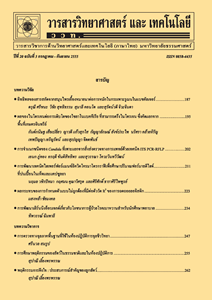Pseudomonas fluorescens ผลิตสารพอลิแซคคาไรด์ส่งเสริมการเจริญเติบโตมันสำปะหลังและควบคุมโรครากและหัวเน่า
Main Article Content
Abstract
บทคัดย่อ
Pseudomonas fluorescens ผลิตสารพอลิแซคคาไรด์ 2.8 กรัม/ลิตร ใน nutrient glucose broth ที่เติมน้ำตาลกลูโคส 7.5 กรัม/ลิตร สารพอลิแซคคาไรด์ถูกนำไปทดสอบประสิทธิภาพในการส่งเสริมการเจริญเติบโตมันสำปะหลัง พันธุ์ระยอง 9 และควบคุมโรครากและหัวเน่าเปรียบเทียบกับสารเคมีป้องกันกำจัดเชื้อราแคปแทนและสารสังเคราะห์ salicylic acid (SA) ซึ่งเกษตรกรนิยมใช้ การทดสอบเริ่มต้นโดยแช่ท่อนพันธุ์มันสำปะหลังในสารพอลิแซคคาไรด์ความเข้มข้น 100, 200, 500 และ 1,000 ppm เปรียบเทียบกับ SA ความเข้มข้น 5.2 mM แคปแทน อัตรา 160 กรัม/น้ำ 20 ลิตร และน้ำกลั่นนึ่งฆ่าเชื้อ ต้นมันสำปะหลัง อายุ 1 เดือน ที่ผ่านการแช่ท่อนพันธุ์ด้วยสารพอลิแซคคาไรด์ 500 ppm มีความสูงต้น ความยาวราก และจำนวนรากสูงสุด 5.83 เซนติเมตร, 13.9 เซนติเมตร และ 49.53 ราก; และ 28.3 เซนติเมตร, 15.27 เซนติเมตร และ 52.52 ราก ในสภาพเรือนปลูกพืชทดลอง; และสภาพไร่ ตามลำดับ ซึ่งแตกต่างทางสถิติจากกรรมวิธีควบคุม (p=0.05) ยิ่งไปกว่านั้นสารพอลิแซคคาไรด์ 500 ppm สามารถส่งเสริมการเจริญเติบโตมันสำปะหลังอายุ 3 เดือน ได้ดีในทิศทางเดียวกัน รวมทั้งสารพอลิแซคคาไรด์ 200 ppm ยังสามารถกระตุ้นให้มันสำปะหลังสะสมฮอร์โมนพืช indole-3-acetic acid (IAA) อย่างรวดเร็วเท่ากับ 14.96 และ 17.98 ไมโครกรัม/มิลลิกรัม น้ำหนักสด ภายใน 4 วัน หลังพ่นใบเมื่อมันสำปะหลังอายุ 2 และ 3 เดือน ตามลำดับ ซึ่งแตกต่างทางสถิติกับกรรมวิธีควบคุม (p=0.05) ส่งผลให้มันสำปะหลังต้านทานโรครากและหัวเน่าได้ดีไม่แตกต่างทางสถิติกับสารเคมีแคปแทนและ SA ซึ่งลดการระบาดของโรครากและหัวเน่าได้ 65-77 % ภายใต้สภาพเรือนปลูกพืชทดลองและสภาพไร่ (p=0.05) แสดงให้เห็นว่าสารพอลิแซคคาไรด์มีประสิทธิภาพในการส่งเสริมการเจริญเติบโตมันสำปะหลังและสามารถควบคุมโรครากและหัวเน่าได้ดีมีแนวโน้มใช้ได้จริงในสภาพไร่
คำสำคัญ : จุลินทรีย์ปฏิปักษ์; แบคทีเรียส่งเสริมการเจริญเติบโตพืช; การควบคุมโดยชีววิธี
Abstract
Pseudomonas fluorescens produced polysaccharides with 2.8 g/L dry weight in nutrient glucose broth with 7.5 g/L of glucose. The polysaccharides was evaluated for enhancing growth of cassava plant cv. Rayong 9 and controlling root and tuber rot compared to fungicide, Captanand the synthesis chemical, salicylic acid (SA) applied by farmers. The investigation was soaked the cassava stakes with 100, 200, 500, and 1,000 ppm of polysaccharides compared with 2.5 mM of SA, Captan (160 g/20 L of water) and ddH2O. The cassava stakes soaked with the 500 ppm of polysaccharides significantly increased stem height, root length and number of root with 5.83 cm, 13.9 cm, and 49.53 roots and 28.3 cm, 15.27 cm, and 52.52 roots after 1 month cultivation under greenhouse and field conditions, respectively compared with control treatments (p=0.05). Moreover, the stem height, root length, and number of root significantly increased by the 500 ppmof polysaccharides application under both conditions until 3 months cultivation (p=0.05). Also, the polysaccharides triggered significantly increased expression of plant growth hormones, indole-3-acetic acid (IAA) immediately after foliar sprayed with the 200 ppm of polysaccharides at 2 and 3 months days old plant reaching peak levels at 4 days after application with 14.96 and 17.98 µg/mg fresh weight compared to control treatments (p=0.05). Different concentrations of the polysaccharide, Captan and SA showed non-significantly decrease in root and tuber rot incidence with 65-77 % under greenhouse and field experiments (p=0.05). Therefore, its possible that polysaccharides can be used in the cassava plant production system under field conditions.
Keywords: antagonistic microorganism; plant growth promoting bacteria; biocontrol


